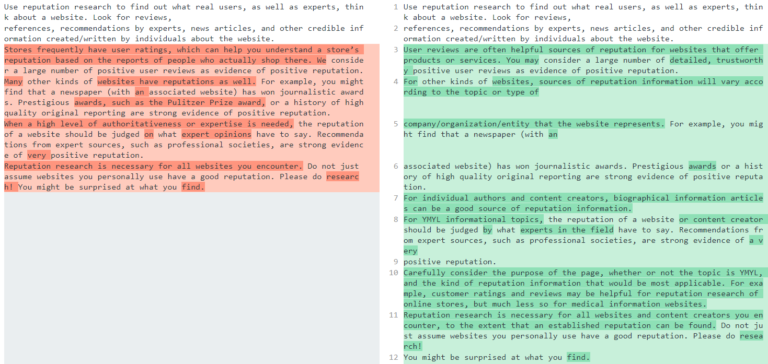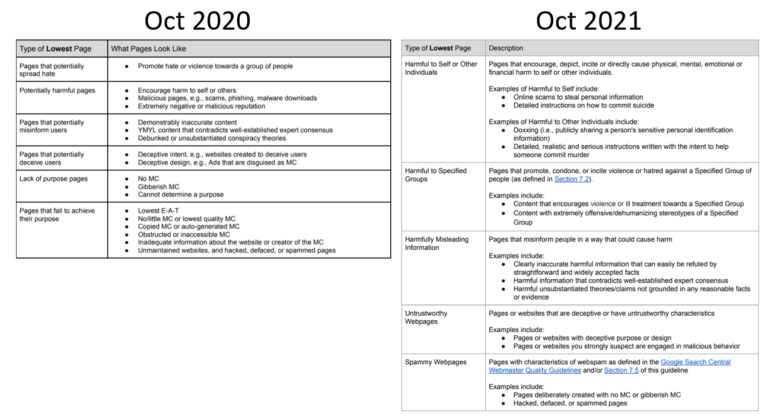Google announced five updates to its Search Quality Raters Guidelines (QRGs) today and issued an updated version of the document with a brief explanation of each one in its changelog.
While these guidelines have no direct impact on rankings, they give us valuable insight into the many factors Google considers when assessing content quality.
Furthermore, the guidelines are used to train human search quality evaluators, whose feedback is benchmarked and used to inform future Google algorithm updates.
Paying close attention to changes made to the QRG can help to inform the future direction Google may be headed in its changes to the algorithms, and the types of nuance it looks for when it evaluates content and E-A-T.
What’s New In The Search Quality Rater Guidelines October 2021 Update?
- The definition of ‘Groups of people’ in the YMYL category has changed.
- How to research reputation information for websites and creators has been refreshed.
- The ‘Lowest Page Quality’ section has changed substantially.
- The definition of ‘Upsetting-Offensive’ has been updated.
- Edits for clarity and consistency throughout.
What do these changes to the guidelines mean, and what do SEO professionals need to know about them?
Advertisement
Continue Reading Below
1. ‘Groups Of People’ In YMYL Content
Google’s update: “Expanded the definition of the YMYL subcategory ‘Groups of people.’”
Previously, Google’s definition of YMYL – “Your Money, Your Life” included a section about “Groups of people” that included information related to “race or ethnic origin, religion, disability, age, nationality, veteran status, sexual orientation, gender or gender identity.”

Google kept those groups in its definition, but added the following classifications to its definition of groups of people:
Advertisement
Continue Reading Below
- Caste.
- Gender expression.
- Immigration status.
- Sex/gender.
- Victims of a major violent event and their kin.
- Or any other characteristic that is associated with systemic discrimination or marginalization.
This shows that Google is working to expand its notions of YMYL content to include various identities, socioeconomic conditions, and more.
Because E-A-T is of the utmost importance for YMYL content, this implies that E-A-T is crucial when publishing content related to any of the above groups of people.
2. How To Research Reputation Information
Google’s update: “Refreshed guidance on how to research reputation information for websites and content creators.”
Google changed its language from stating that “stores” frequently have user ratings that can provide reputation information to state that this can be done for “websites.”
It also added a large number of “detailed, trustworthy, positive” reviews can be evidence of a good reputation whereas before, Google only mentioned the number of positive reviews.

Google removed the example of the Pulitzer Prize as evidence of a positive reputation for a journalism website. Google has also added and removed mentions of the Pulitzer Prize in previous iterations of the QRG.
Google adjusted its definition of how reputation should be measured on the individual/website level by adding to the QRG that “for individual authors and content creators, biographical information articles can be a good source of reputation information.”
They also switched the language from “when a high level of authoritativeness or expertise is needed,” to “For YMYL informational topics.”
This is another example of Google blending notions of YMYL with requiring the highest levels of E-A-T.
Interestingly, Google removed the statement that “reputation research is necessary for all websites.” Instead, reputation research is only necessary “to the extent that an established reputation can be found.”
Google also encourages raters to consider whether or not the topic is YMYL and to assess reputation accordingly. Google included the example that user reviews are helpful for an online store, but not as much for a medical information website.
This is an important update because it indicates that user reviews may be more important for sites that deal with customers than with medical (or other YMYL) websites, whose E-A-T may be calculated differently.
Advertisement
Continue Reading Below
3. ‘Lowest Page Quality’
Google’s update: “Restructured and updated ‘Lowest Page Quality’ section; reorganized and refreshed examples to reflect new structure.”
Google made significant changes to make its section about how it calculates the Lowest Page Quality.
Most importantly, it expanded definitions and provided specific examples of what it means for a page to cause harm, spread hate, or misinform users.

Some examples of these additions include:
Advertisement
Continue Reading Below
- Websites that doxx users.
- Content containing instructions on committing suicide or homicide.
- Content that contains offensive or dehumanizing stereotypes.
- Harmful content that can be easily refuted by widely accepted facts.
- Unsubstantiated theories that are not grounded in facts or evidence.
4. ‘Upsetting-Offensive’ Definition
Google’s update: “Simplified the definition of ‘Upsetting-Offensive’ to remove redundancy with Lowest Page Quality section.”
Google completely overhauled its definition of “Upsetting-Offensive” to make it more brief and concise.
The definition still maintains that content should be classified as “upsetting-offensive” if it can be considered as such according to searchers from that locale.
Google also removed the statement that a result should be considered “upsetting-offensive” even if it satisfies user intent.

5. Minor Changes Throughout
Google’s update: “Minor changes throughout (updated screenshots and URLs, wording, and examples for consistency; removed outdated examples; fixed typos; etc.).”
Advertisement
Continue Reading Below
As Danny Sullivan, Public Search Liaison, explained in the blog post announcing the updates:
“Just like we make improvements to Search, we update the rater quality guidelines from time to time to make sure they’re working as intended.”
Later, he added:
“Other changes focus on things like refreshing the language for clarity and updating organization. That’s what made up most of our October 2021 update, which included clarifications of what constitutes lowest quality content, and refreshed and modernized guidance on researching the reputation of websites.”
Search Quality Rater Guidelines Come With A Changelog
Google seems committed to being more transparent in how and when the QRGs are updated and has kept a changelog of updates at the end of the document since December 2019.
Staying on top of updates to these guidelines can help marketers keep up with Google’s understanding of what makes for a quality search experience and how to optimize your own content accordingly.
More Resources:
Advertisement
Continue Reading Below
Featured image: Fonstra/Shutterstock
In-article images: Created by author.
